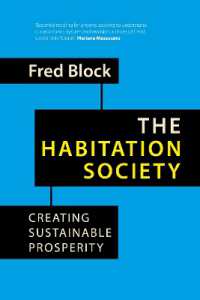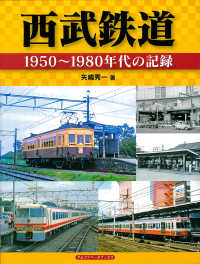- ホーム
- > 洋書
- > 英文書
- > History / World
Full Description
The Roman road system was the main service infrastructure for administrative management, economic operation and defense of the empire. Along with roads, a key element of this infrastructure were the resting places more or less directly linked with vehiculatio / cursus publicus, or with a system run or controlled by the state to ensure essential services (safe stop, supplies, maintenance of horses and other animals) to those traveling on behalf of the public administration. New archaeological research and new studies on a rich and diverse body of extra-archaeological sources have recently reported the attention of the international scientific community on the subject of parking places, within the more general theme of the smaller settlements in the Roman world and their evolution in late antiquity and early medieval times. This volume brings together contributions from scholars from three different generations, starting from different sources and methodological approaches, converging towards the construction of an area of common reflection on a theme still relatively underdeveloped. The goal is to lay the foundation for a deepening of the interdisciplinary debate and to develop new research projects.
Contents
I. IL PROFILO STORICO; Introduzione; Mansiones and cursus publicus in the Roman Empire / Mansiones e cursus publicus nell'impero romano (Anne KOLB); Mansiones e stathmoi nelle fonti letterarie tardoantiche: destinazione d'uso, equipaggiamento, immagini / Mansiones and stathmoi in literary sources of Late Antiquity: their destinations, equipment, descriptions (Lucietta DI PAOLA); Les mansiones et mutationes dans les textes juridiques de l'Antiquité et du Haut Moyen Âge; / Mansiones and mutationes in legal texts of the Antiquity and Early Middle Ages (Sylvie CROGIEZ-PETREQUIN); Le stazioni di sosta negli itineraria romani / The road stations in Roman itineraria (Patrizia BASSO); Inter vias latrones sum passus (CIL VIII 2728, 18122): morire lungo le strade romane / Inter vias latrones sum passus (CIL VIII 2728, 18122): dying on Roman roads. (Alfredo BUONOPANE); Gli Stationarii / The Stationarii (Federica PETRACCIA); Luoghi di strada e stazioni stradali in Italia tra età tardoantica e alto Medioevo / Street villages and road stations in Italy between Late Antiquity and the early Middle Ages (Cristina CORSI); II. INTERSEZIONI DELLA RICERCA; Qualche appunto per un'archeologia contestuale delle stazioni di sosta nel mondo romano e tardoantico / Some notes about a contextual archaeology of road stations in Roman; and Late Antique world (Enrico ZANINI); Identifier une auberge romaine: quelques réflexions méthodologiques / Methodological Thoughts on the Identification of Roman Inns (Marie-Adeline LE GUENNEC); Lavarsi in viaggio e in albergo: alcune osservazioni sui balnea per i viaggiatori / Baths and bathing on the road and in the city: some observations about balnea for travelers (Maura MEDRI); Edifici per animali di età romana: tra fonti, archeologia e scienza / Roman buildings for animals: between sources, archeology and science (Maria Stella BUSANA, Mara MIGLIAVACCA, Diego PIZZEGHELLO, Serenella NARDI); Alcune statistiche sulle dinamiche cronologiche degli insediamenti secondari in Italia nella lunga durata tra età romana e Medioevo / Some statistics on the chronological dynamics of secondary settlements in Italy during the long-term between the Roman period and the Middle Ages (Angelo CASTRORAO BARBA); III. CASI DI STUDIO; Una villa rustica-mansio a Brentino Belluno (VR) in Valdadige / A Roman rural villa-mansio in Brentino Belluno (VR), Valdadige (ZACCARIA RUGGIU); Lo scavo di via Cantore 18 a Verona: ipotesi di una stazione di sosta alle porte della città / The statio of the via Cantore 18 site in Verona: a hypothetical mansio at the edge of the Roman city (Tecla GOTTARDI, Cecilia ZANETTI, Elisa ZENTILINI); In viaggio verso la Valle Sabbia. Una stazione di sosta a Gavardo (BS)? I dati archeologici / A Roman mansio found in Gavardo, Brescia. The archaeological evidence (Elisa ZENTILINI); La mansio ad Solaria della Tabula Peutingeriana? Un contesto inedito di recente indagine nel comune di Calenzano (FI) / The mansio ad Solaria of the Tabula Peutingeriana? A; recently investigated site in the municipality of Calenzano (FI) (Daria PASINI, Marco BONAIUTO, Francesco CARRERA); La villa-mansio di Vignale: vivere e viaggiare nell'Etruria costiera tra il I e il V secolo d.C. / The villa-mansio of Vignale: living and travelling in the coastal Etruria between the 1st and the 5th century A.D (Elisabetta GIORGI); Santa Cristina in Caio a Buonconvento (SI): diacronia di un central place / Santa Cristina in Caio (Buonconvento - SI): diachrony of a central place (Stefano BERTOLDI, Marco VALENTI); Una probabile mansio marittima in località Columna (Civitavecchia) / A probable maritime mansio at Columna (Civitavecchia) (Carlotta BASSOLI, Teresa LEONE, Carlo PAVOLINI, Annamaria VILLARI); Blera e Sub Lupatia (It. Ant. 121,4-5): proposte per l'identificazione di due stazioni itinerarie lungo il tratto apulo della via Appia / Blera and Sub Lupatia (It. Ant. 121,4-5): proposals for the identification of two stationes of the via Appia in Apulia (Luciano PIEPOLI); Mutatio Aquilonis e Ad Pirum dagli Itineraria al riscontro sul terreno. Nuovi dati da due stationes della via Traiana / Mutatio Aquilonis and Ad Pirum from Itineraria to ground truthing. New data from two stationes along the via Traiana (Giuseppe CERAUDO, Veronica FERRARI); L'antica via Acrense e l'insediamento rurale di contrada Bagni (SR) / The ancient via Acrense and the rural settlement of Bagni (SR) (Santino Alessandro CUGNO); Stations routières, villas et 'plurifonctionnalité' des 'bâtiments de bord de route'. Apport de quelques opérations d'archéologie préventive / Road stations, villas and multifunctional nature of the roadside sites. The contribution of rescue archaeology interventions (Philippe LEVEAU); Infrastrutture lungo la via dell'Ambra in Pannonia: le stationes di Nemescsó e Sorokpolány (Ungheria) / Infrastructures along the Amber Road in Pannonia: the road stations of Nemescsó and Sorokpolány (Hungary) (Stefan GROH, Helga SEDLMAYER); Raccontare una mansio in un progetto di archeologia pubblica / Building the image of a mansio in a public archaeology project (Samanta MARIOTTI, Nina MAROTTA, Francesco RIPANTI)








